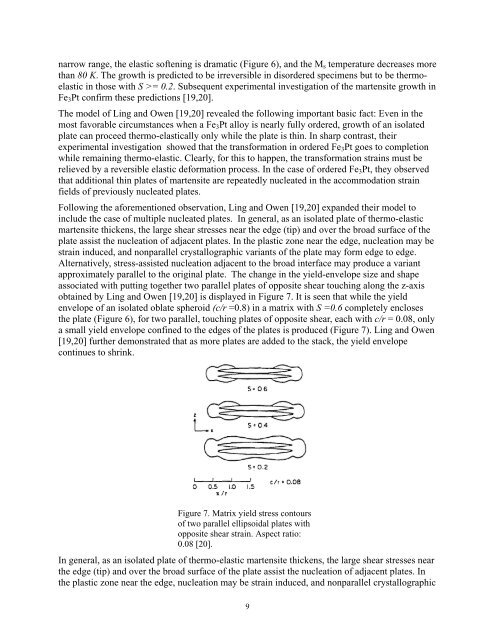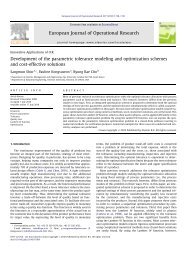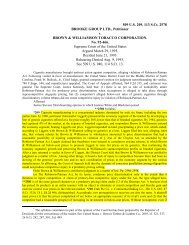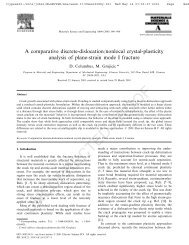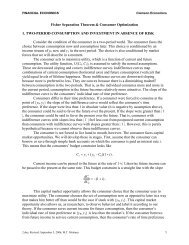a tribute to professor walter shepherd owen - Clemson University
a tribute to professor walter shepherd owen - Clemson University
a tribute to professor walter shepherd owen - Clemson University
You also want an ePaper? Increase the reach of your titles
YUMPU automatically turns print PDFs into web optimized ePapers that Google loves.
narrow range, the elastic softening is dramatic (Figure 6), and the Ms temperature decreases more<br />
than 80 K. The growth is predicted <strong>to</strong> be irreversible in disordered specimens but <strong>to</strong> be thermoelastic<br />
in those with S >= 0.2. Subsequent experimental investigation of the martensite growth in<br />
Fe3Pt confirm these predictions [19,20].<br />
The model of Ling and Owen [19,20] revealed the following important basic fact: Even in the<br />
most favorable circumstances when a Fe3Pt alloy is nearly fully ordered, growth of an isolated<br />
plate can proceed thermo-elastically only while the plate is thin. In sharp contrast, their<br />
experimental investigation showed that the transformation in ordered Fe3Pt goes <strong>to</strong> completion<br />
while remaining thermo-elastic. Clearly, for this <strong>to</strong> happen, the transformation strains must be<br />
relieved by a reversible elastic deformation process. In the case of ordered Fe3Pt, they observed<br />
that additional thin plates of martensite are repeatedly nucleated in the accommodation strain<br />
fields of previously nucleated plates.<br />
Following the aforementioned observation, Ling and Owen [19,20] expanded their model <strong>to</strong><br />
include the case of multiple nucleated plates. In general, as an isolated plate of thermo-elastic<br />
martensite thickens, the large shear stresses near the edge (tip) and over the broad surface of the<br />
plate assist the nucleation of adjacent plates. In the plastic zone near the edge, nucleation may be<br />
strain induced, and nonparallel crystallographic variants of the plate may form edge <strong>to</strong> edge.<br />
Alternatively, stress-assisted nucleation adjacent <strong>to</strong> the broad interface may produce a variant<br />
approximately parallel <strong>to</strong> the original plate. The change in the yield-envelope size and shape<br />
associated with putting <strong>to</strong>gether two parallel plates of opposite shear <strong>to</strong>uching along the z-axis<br />
obtained by Ling and Owen [19,20] is displayed in Figure 7. It is seen that while the yield<br />
envelope of an isolated oblate spheroid (c/r =0.8) in a matrix with S =0.6 completely encloses<br />
the plate (Figure 6), for two parallel, <strong>to</strong>uching plates of opposite shear, each with c/r = 0.08, only<br />
a small yield envelope confined <strong>to</strong> the edges of the plates is produced (Figure 7). Ling and Owen<br />
[19,20] further demonstrated that as more plates are added <strong>to</strong> the stack, the yield envelope<br />
continues <strong>to</strong> shrink.<br />
Figure 7. Matrix yield stress con<strong>to</strong>urs<br />
of two parallel ellipsoidal plates with<br />
opposite shear strain. Aspect ratio:<br />
0.08 [20].<br />
In general, as an isolated plate of thermo-elastic martensite thickens, the large shear stresses near<br />
the edge (tip) and over the broad surface of the plate assist the nucleation of adjacent plates. In<br />
the plastic zone near the edge, nucleation may be strain induced, and nonparallel crystallographic<br />
9


